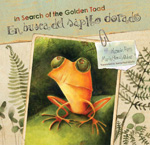A Turtle and a Toad Enter the Pachanga Family
By Jim Parisi
 In Tortuguero at the break of dawn, a baby turtle cracks through the shell of its egg and begins its perilous trek through prospective predators and other dangers in order to unite with the raging sea that beckons.
In Tortuguero at the break of dawn, a baby turtle cracks through the shell of its egg and begins its perilous trek through prospective predators and other dangers in order to unite with the raging sea that beckons.
At the dawn of time, according to Bribri legend, there was an only mountain, at the top of which countless toads held up an immense spherical stone that emitted strange noises. The toads, who were all the same color, had been told by their creator that their mission was to protect the stone and keep it from breaking apart.
These are the openings of the two new bilingual books for young readers from the Costa Rican publishing company Pachanga Kids, their fifth and sixth in the series.
The noted Costa Rican poet Rodlolfo Dada wrote the lyrical storyline for “Una Tortuguita Sale del Nido (A Turtle is Born)” and Wen Hsu, who was born in Taiwan to Chinese parents and moved to Costa Rica at the age of two, contributed the wonderful artwork. The work by these two artists compliments each other in this amazing union of talent. I cannot stress enough the incredible marriage of medias accomplished by this book. And Eliot Greenspan did a good job in the translation to English to preserve the rhythmic flow of the story. The book is intended for children three years of age and older. I think the author’s delivery of information to the young reader feels unobtrusive, therefore much easier for the kids to digest.
 Yazmin Ross, one of the founders of Pachanga Kids, is no stranger to adapting stories. At the age of seven, her son created a story about a group of fish who wanted to sweeten the ocean with sugar. Ms Ross remembered and treasured this story for twenty years and used it as the premise for “El Mar Azucarado (The Sea Sweet Sea)”, the first Pachanga publication. For “En Busca del Sapito Dorado (In Search of the Golden Toad)”, Ross has elaborated on an oral history of Creation from the Caribbean indigenous culture in Costa Rica. It is quite a responsibility bestowed upon the poor, uniformly-colored toads, and luckily for us, they eventually were unable to hold the rock and keep it from opening and creating every form of life we know. Yazmin told me she relocated the story to Monteverde to help children understand the plight of the Golden Toad and that she did not depict them as extinct because she wants the children to embrace a sense of hope. Again, it is the telling of the story, alongside the mesmerizing illustrations by the Venezuelan artist Maria Elena Valdez that take the book to another plateau. Valdez contributed the artwork for an earlier Pachanga publication and it is nice to see more of her talents applied to the Pachanga publications.
Yazmin Ross, one of the founders of Pachanga Kids, is no stranger to adapting stories. At the age of seven, her son created a story about a group of fish who wanted to sweeten the ocean with sugar. Ms Ross remembered and treasured this story for twenty years and used it as the premise for “El Mar Azucarado (The Sea Sweet Sea)”, the first Pachanga publication. For “En Busca del Sapito Dorado (In Search of the Golden Toad)”, Ross has elaborated on an oral history of Creation from the Caribbean indigenous culture in Costa Rica. It is quite a responsibility bestowed upon the poor, uniformly-colored toads, and luckily for us, they eventually were unable to hold the rock and keep it from opening and creating every form of life we know. Yazmin told me she relocated the story to Monteverde to help children understand the plight of the Golden Toad and that she did not depict them as extinct because she wants the children to embrace a sense of hope. Again, it is the telling of the story, alongside the mesmerizing illustrations by the Venezuelan artist Maria Elena Valdez that take the book to another plateau. Valdez contributed the artwork for an earlier Pachanga publication and it is nice to see more of her talents applied to the Pachanga publications.
Both of these new hardback books are printed in Spanish and English, simultaneously on each page, a nice vehicle for helping your child become bilingual. All of the Pachanga Kids books are available at the Jaime Peligro book stores in Playa Tamarindo and Quepos, where they have open store copies for the customers to check out.

